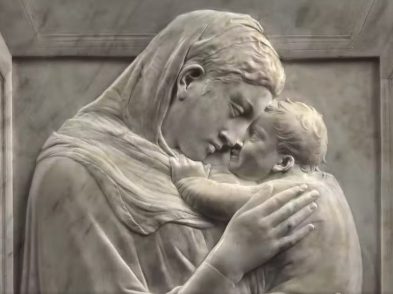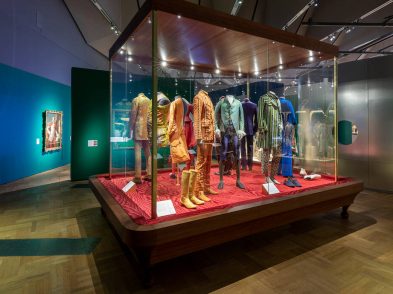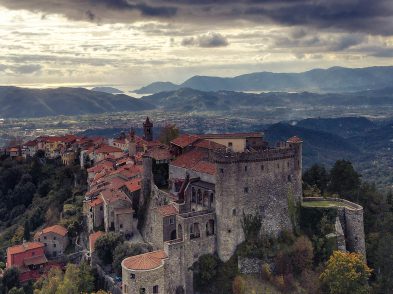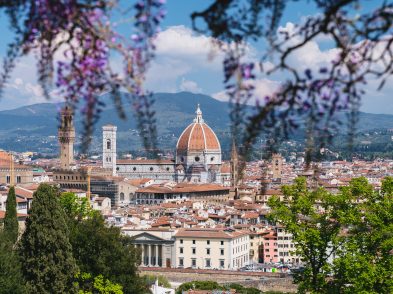Pier Soderini (1452-22) was in charge of the Florentine government at a turbulent time politically speaking, but in a golden age as far as the arts were concerned. Masterpieces were on every corner and you bumped into geniuses at every turn. Raffaello was on his way. He introduced himself to the Gonfaloniere with a letter of recommendation dated October 1, 1504, delivered in Urbino by Giovanna Feltria, the powerful widow of Giovanni della Rovere, a relative of Pope Sisto IV. Soderini didn’t make much of it and the young painter had to find private patrons while watching the two great artists, Michelangelo and Leonardo, competing to decorate the Palazzo Vecchio’s Salone dei Cinquecento. Raphael (1483-1520) was born in Urbino, the intellectually sophisticated city-state, where Perugino was the painting star. Raphael was a smart and talented boy, who soon became the older painter’s assistant and promptly assimilated his style and technique. He was quick to learn, which is why the ambitious “apprentice” moved to Florence to learn more. Florence proved to be his springboard to everlasting glory in Rome, until his death in 1520.
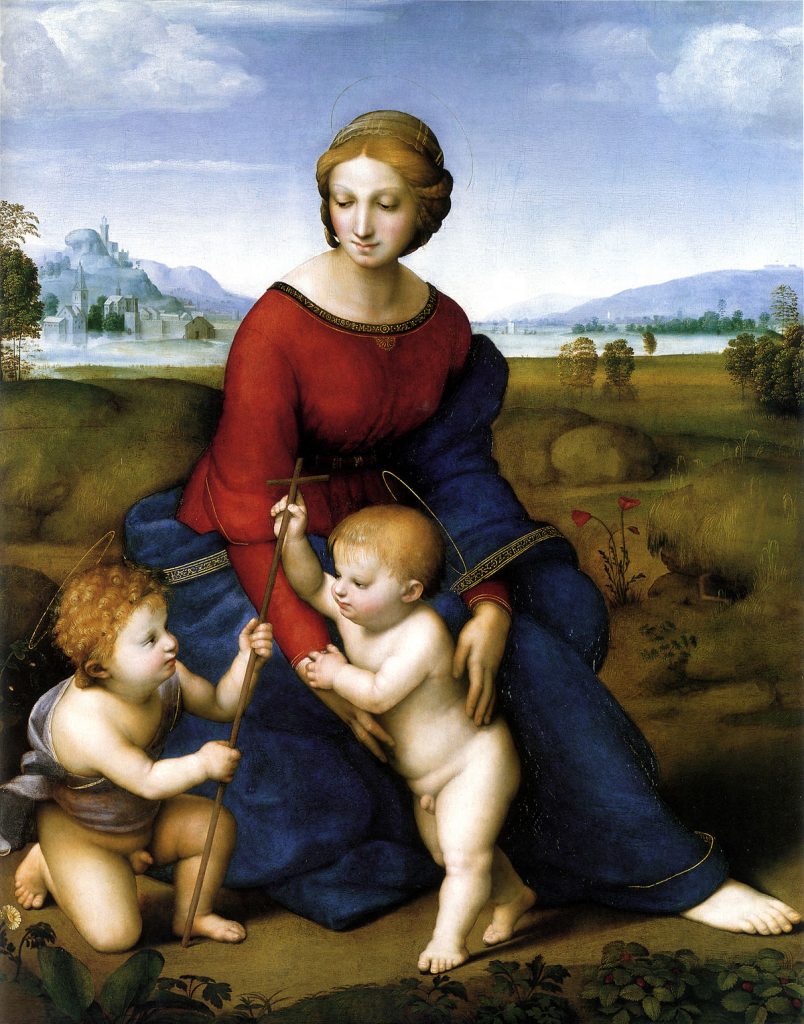
Five hundred years later, The National Gallery in London has assembled the most complete exhibition on Raphael’s astonishing achievements, whose drawings and stanze in the Vatican went head-to-head with Michelangelo’s ceiling in the Sistine Chapel. The exhibition Raphael (April 9-July 31) was delayed due to the pandemic, but will open on April 9 amid great expectations and international glamour.
Leading museums and prestigious private collections, with significant contributions from The Queen, have loaned items, paving the red carpet for the “enfant prodige” of the Italian Renaissance. The blockbuster exhibition at the National Gallery provides an overview of Raphael’s work, from his early paintings in Urbino to the Florentine period and Roman apotheosis. As a painter, draughtsman, architect, designer and archaeologist, Raphael is explored in every aspect of his multimedia activity, including poetry.
Vasari described him an “universal Artist” for the mastery Raphael developed in printmaking, decorative art and tapestry design, as well as his architecture and archaeological work as a surveyor of Ancient Rome. Famous is his descent with ropes into the mysterious darkness of the ruins of Domus Aurea with Michelangelo. There was no love lost between Raphael and Michelangelo, who considered the “urbinate” a shameless upstart, a complacent fop and a pet of popes. Raphael was actually charming: he knew how to curry favor and was definitely more gracious or diplomatic than the Florentine artist. He was also very good at his job, but he climbed the ladder of fame and fortune thanks to this competition with the two Florentine geniuses and the Florentine artistic environment. Florence was his testing bench, where he got in touch with Antonio da Sangallo, Andrea Sansovino, Ridolfo del Ghirlandaio and Baccio D’Agnolo, to name a few. It is also where he studied Donatello and Masaccio and bore witness to the production of the two giants, Leonardo and Michelangelo. In the meantime, he painted Madonnas.
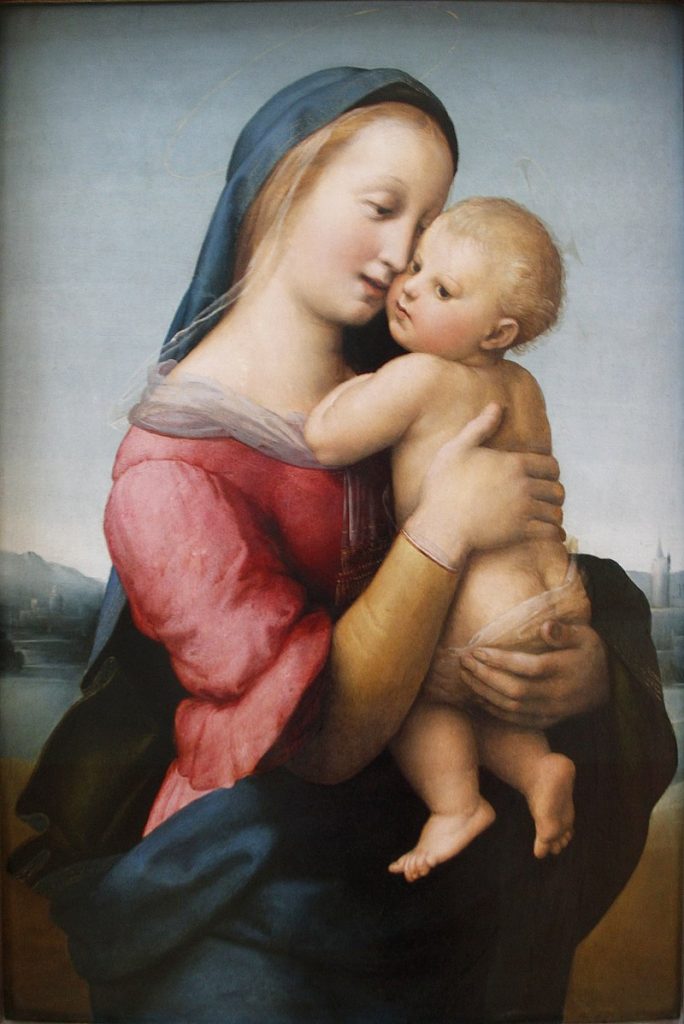
He felt a bit snubbed by Florence. During his stay there (1504-08), he only had to finish previously commissioned works, such as the Ansidei Madonna, Madonna of the Pinks and the Terranuova Madonna, on show in the London exhibition. Commissioned by wealthy Florentine families, Raffaello painted masterpieces such as La Belle Jardinière, Madonna del Cardellino, Madonna del Belvedere, Madonna of the Palm, where influences from Leonardo are recognizable, or The Bridgewater Madonna, recalling Michelangelo’s Tondo Taddei.
Canigiani, Nasi, Tempi and other established Florentines had their sacred painting done by the young artist, but no everlasting outstanding patron transpired. Taddeo Taddei, a clever merchant with a soft spot for the arts and a keen eye for investments, hosted and cherished Raphael, who is said to have commented, “I am more obliged to Taddei than to any man alive”. Not only for being his honored guest at Palazzo Taddei at Via de Ginori 10, but also for introducing him to more clients. For Taddei, he painted the wonderful Madonna Belvedere, supervising Jesus and St. John playing in a countryside environment reminiscent of Leonardo’s background. For his powerful friends, he painted the impressive portraits of Agnolo Doni and Maddalena Strozzi to celebrate their wedding. Raphael enjoyed growing credit among the high and mighty, but he did not find it easy to gain public commissions in Florence.
It was no surprise that he quickly seized the opportunity for a change of scene. Rome was calling and Raphael left abruptly in the summer of 1508, leaving the Madonna del Baldacchino unfinished, which the Dei family had commissioned for their chapel in Santo Spirito. Sienese banker Agostino Chigi paved his way in the Vatican, which transformed his status as an artist, cherished as he was by Giulio II and Leone X. His Roman years saw him applying his talents widely, rocketing his career to the stars.
The upcoming exhibition at the National Gallery benefits from loans from the Louvre, Uffizi, Prado, Hermitage and the Vatican Museums, demonstrating creative progress in a range of astonishing works, which confirm the National Gallery’s reputation of organizing world-class exhibitions. The Florentine Madonnas brought Raphael good luck. Among so many impressive masterpieces, one of my favourite remains the Madonna Tempi, on loan from the Munich Pinakothek (Ludwig of Baviera purchased the painting from the Tempi family in 1829). One of the simplest but most affecting images of the Virgin Mary with Baby Jesus, it resembles Donatello’s Verona Madonna, but Raphael infused gentle and easy grace in this intimate embrace of Mother and Child, their faces tenderly touching, inspiring deep tenderness and confirming the artist’s extraordinary pictorial imagination and poetic hand.


